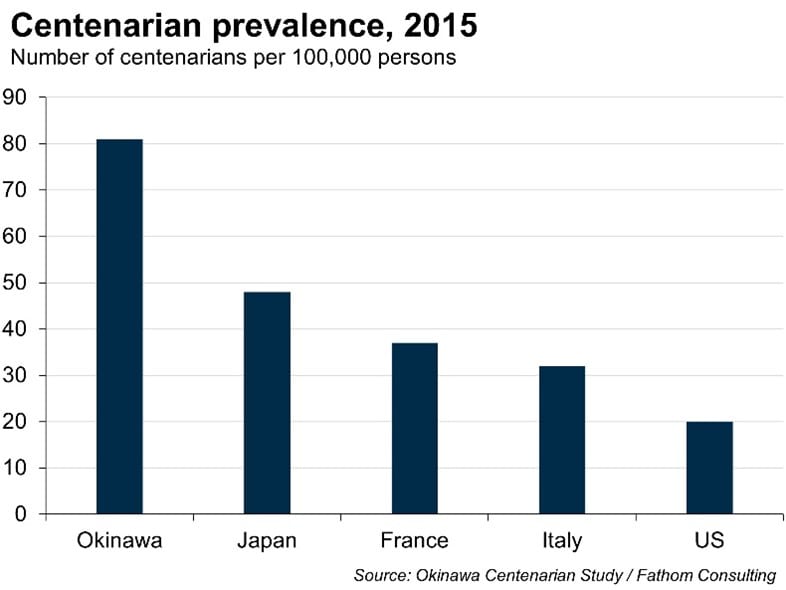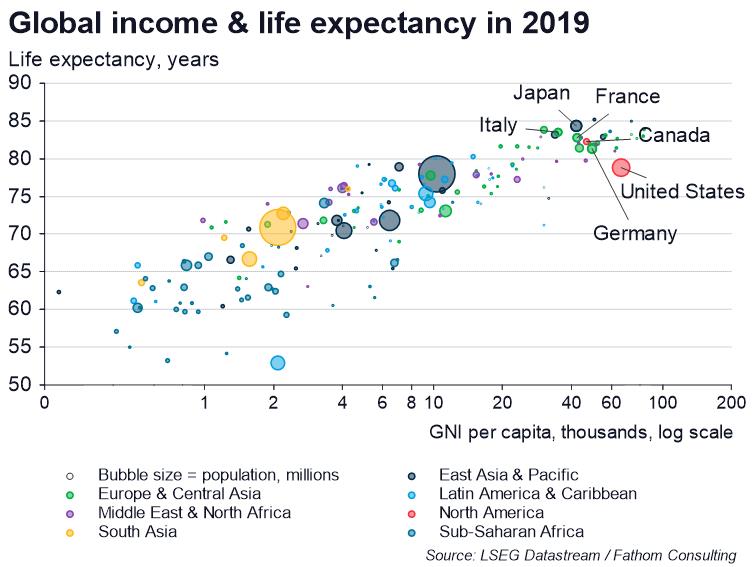A sideways look at economics
I recently came across a Netflix series: ‘Live to 100: Secrets of the Blue Zones’. The series discusses so-called ‘Blue Zones’ – a zone with the highest life expectancy or the highest proportion of people who reach age 100 (i.e., centenarians). Five Blue Zones have been identified in the world – the Barbagia region (Sardinia), Ikaria (Greece), Nicoya (Costa Rica), Seventh Day Adventists (US) and Okinawa (Japan). The chart below indicates the share of the population that are centenarians in Okinawa vs the rest of Japan, and other countries.

A new Blue Zone is visited in each episode, as they look to determine what differences are aiding these people in living longer and healthier lives. In Okinawa (Japan), for example, groups known as ‘moais’ have been created, within which people contribute to a common pot of money to be used in times of crisis, culminating in a financial as well as social support network. In the mountain region Barbagia in Sardinia, the steepness of the streets lead to residents old (and young) gaining exercise every time they leave their home. In Nicoya, one of the poorest regions of Costa Rica, the proportion of centenarians is nearly three and a half times the global average. This is in contrast with the global trend of higher income leading to higher life expectancy (as detailed in the chart below, plotting GNI per capita against life expectancy). The Blue Zones project points to Nicoyans having a clear purpose in life – what they call a ‘plan de vida’ or life plan. They wake up, undertake work serving the community (often physically demanding work, such as grinding corn or chopping wood), and spend the evenings relaxing and socialising with friends.

The last episode looked to clarify why people in those locations lived longer on average and what the most common traits were that connected the different Blue Zones:
- Having a healthy diet rich in vegetables, grains and unprocessed foods, and eating in moderation
- Having a sense of purpose in life. The Costa Rican ‘plan de vida’ can be found repeated in many of the locations observed and, similar to what is named ‘ikigai’ in Japan, people in Blue Zones feel like the work they do, what they contribute, even at an old age, matters in aiding the wider community
- They move naturally. People in Blue Zones don’t do regular work-outs or go to the gym. Instead, through physically intensive work like gardening, sheep herding and chopping wood, they are physically active throughout the day, even at an older age
- Connecting with the local community. Those in Blue Zones prioritise hard work, but when the evening comes, they gather with family, friends, faith-based communities or support groups to socialise and mix.
The project doesn’t come out with any groundbreaking findings for ‘how to live beyond 100 years’ – many of the findings, such as eating a healthy diet and exercising to prolong the chances of living longer and healthier lives, are already widely known. A meta-study found that the additional life expectancy in physically active compared to inactive persons ranged from 0.43 to 6.9 years. [1] In the UK, areas with a larger share of healthy eaters and people who are regularly physically active have a higher life expectancy. [2] Furthermore, some studies have shown that loneliness is a risk factor for mortality. [3] Therefore, for the elderly, having a sense of purpose and community in the Blue Zones may help them live longer lives.
However, what is remarkable about this project is that the results were a lot better than expected when they used the findings to make changes in the way people live their lives across different areas of the US. The Blue Zones project invested in simple changes that had a large impact. In Klamath Falls, Oregon, this among others included dividing the population of an area into walking groups, engaging them both in physical exercise and in creating friendships. Furthermore, in Albert Lea, Minnesota, the project constructed sidewalks to the city centre, so that people could walk rather than drive, and increased the selection of healthy options in grocery stores. Indeed, 2.9 years were added to participants’ projected lifespan within a year of participating in the project. Beach Cities, California, experienced a 68% drop in child obesity at Redondo Beach K-5 schools [4] from 2007 to 2019, after the area joined the Blue Zones project in 2010 in light of its childhood obesity levels being higher than the national average. Furthermore, Fort Worth, Texas, has saved an estimated $81 million per year in health care utilization compared to 2014 (when they joined the Blue Zones project) due to a 6.1 percentage point decrease in the adult smoking rate. [5] Although the project may not be the sole cause of these results, it shows that making a population healthier, through making the healthy option the easy option, works.
So, how does all of this relate to Fathom’s work? In economics, intertemporal choice theory studies people’s decision-making today versus tomorrow. There is a trade-off between consumption today versus tomorrow and, in general, people tend to value the current period higher than the future period. This has implications both on micro- and macro-economic levels. For example, it’s one of the reasons for the creation of an independent central bank. If the government was in charge of interest rates, they might be tempted to reduce interest rates before an election, even if inflation is high. The same theory can be applied to understand why people do not prioritize exercising and eating healthily when it’s been proven to have large health benefits and increase life expectancy. Exercising leads to benefits in the future period, whereas it might be tempting after a long day of work to relax on the sofa rather than go for a run. So, how do you incentivise people to make better decisions for their future? You make the healthy option the ‘nice’ option. For example, adding sidewalks to make it easy to walk, rather than drive, to the city centre, incentivises people to remain active, as does making healthy foods more accessible.
Increasing life expectancy and lower birth rates contribute to a growing proportion of older people in the world, and the share of the population of working age is expected to fall further in high-income countries in the coming decades. According to the World Bank, 20% of the world population will be 60 years or older in 2050. From 2020 to 2050, the number of people who will be 80 years or older is expected to triple. [6] Therefore, the public finances needed to fund care for the elderly grows. If people remain healthier for longer, this would ease some of the future pressure on public finances. Where physically intensive work has been replaced with jobs where people are mostly sedentary and unhealthy diets have become the quick option after a long day of sitting still, this poses a health risk to the population. As does loneliness. Starting walking groups and building sidewalks will not magically solve the problem of an ageing population. However, if small changes can lead to a healthier population, and thus ease the pressure on the public purse, even by a tiny amount, I’d argue it’s worth the investment.
[1] https://www.ncbi.nlm.nih.gov/pmc/articles/PMC3395188/
[2] https://www.ons.gov.uk/peoplepopulationandcommunity/healthandsocialcare/healthandlifeexpectancies/ articles/whataffectsanareashealthylifeexpectancy/2018-01-18
[3] https://www.ncbi.nlm.nih.gov/pmc/articles/PMC5754055/
[4] Grades kindergarten to 5
[5] https://www.bluezones.com/blue-zones-project-results/
[6] https://www.who.int/news-room/fact-sheets/detail/ageing-and-health#:~:text=At%20this%20time%20the%20share,2050%20to%20reach%20426%20million
More by this author